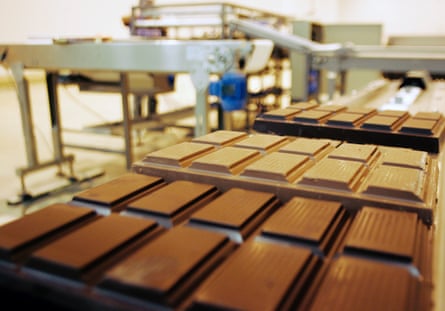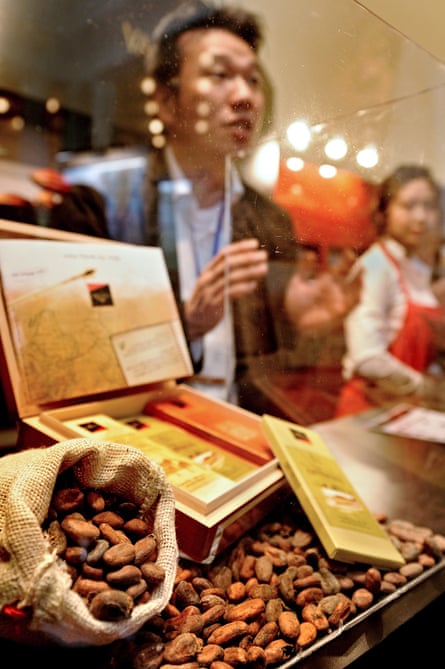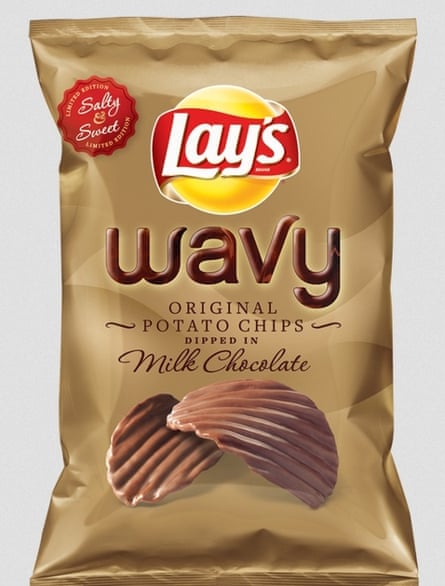THE FARMERS
Ivory Coast
If you’re looking for a place to start telling the story of chocolate, you could do worse than head to Abengourou, in the east of Ivory Coast, the world’s biggest cocoa producer. Farmers have been growing cocoa for generations here – but, in a week of fresh warnings of a global shortage by 2020, they say that their livelihood is far from easy.
They know the hardships; the risk of diseases, inconsistent rains and buyers forcing them to sell at rock-bottom prices. With aging trees that yield fewer pods and the arduous process of harvesting, farmers have been giving up on their plantations.
Adou Leon, 34, switched to rubber seven years ago. “I know the difficulties that my parents faced with cocoa. This really did not encourage me to start planting cocoa,” he says, adding that “all the young people are turning to rubber.” He believes cocoa could even disappear from this area one day. Another disillusioned cocoa farmer, 40-year-old Armaud Kakou, says he did not want to give up the family tradition of cocoa but, financially, he had no choice. “The people wearing the ties [the government] don’t care about the farmers,” he says. “The farmer has no say. It is miserable.”

The government tells a different story. It says the raft of cocoa reforms it introduced in 2012 to try to keep farmers in the industry – including a return to price fixing – has raised incomes by 30%. And in general, the industry is booming in Ivory Coast. This year’s crop was the largest in the West African nation’s history at nearly 1.8m tonnes of beans; an increase of more than 10% on 2013. It coincided with the government raising the farmer price, for the second year in a row, to 850 CFA francs (£1.02)) per kilo.
On the other side of the country to Abengourou, farmers are in a better mood. “We are very happy with the price,” says Souleymane Bamba, a cocoa farmer from Biankouma in the rich, mountainous region in the west of the country known for growing coffee, not cocoa. Bamba starting growing cocoa three years ago after seeing other farmers in the area doing the same, believing he would get more money. Despite real fears of Ebola – badly hit Liberia and Guinea are just across the border – there has been no impact on exports yet. “There are more young plantations, like mine, starting up,” says Bamba. “ I think cocoa is only going to grow every year.”
THE PROCESSORS
INDONESIA
When the cocoa bean leaves the farm, it’s still a long way from the world’s favourite treat. To get it a step closer, huge processing plants such as those found in Indonesia are essential. But even in this country – the world’s third-biggest producer – stagnating harvests and heavy demand mean that more and more of the beans that wind up in those plants are coming from other nations – including Ivory Coast.
Indonesia’s problem lay in a troubled, $350m (£223m) cloning experiment that ran in 2009. It was supposed to flood the country’s cocoa farms with 70m disease-resistant, fast-growing seedlings; the government predicted yields would reach 1m tonnes annually. Instead the harvest is in decline, beset on all sides by disease, old age and the cocoa pod borer, a tiny moth that is the bane of Asia’s cocoa growers. Eight years ago production was 600,000 tonnes a year. Now it is just 490,000.
“At the beginning we processed 100% Indonesian beans, but right now there is a local deficit,” says Thomas Jasman, supply chain director at a cocoa grinder on the outskirts of Jakarta, BT Cocoa, where 45% of beans come from Ivory Coast. Domestic demand is such that the BT Cocoa plant runs 24 hours a day. Says Jasman: “Basically, cocoa grinders in Indonesia have been increasing their capacity during the past five years, but the local bean production hasn’t been what we expected.”
Domestic chocolate consumption is growing more than 20% a year, according to the Indonesian Cocoa Industry Association, while rising demand in China, Asia’s largest chocolate market, has foreign companies rushing to break into the region. Cargill, Barry Callebaut and Olam International are all expanding grinding operations in Indonesia.
“We’ve seen a double-digit growth for powder demand annually,” says Jasman. “I think, fundamentally, with a good economy, better purchasing power, increasing middle class, you have these snacks flying off the shelves.”
THE CORPORATIONS
SWITZERLAND
They may be expanding grinding operations in Indonesia, but Barry Callebaut, the world’s largest chocolate company, keeps its central nervous system firmly based in a country that is synonymous with the stuff: Switzerland.
You have probably never heard of Barry Callebaut, but you are more than likely to have tasted the company’s products. It produces chocolate for Cadbury’s owner Mondelez, Hershey, Unilever, which owns Magnum and Ben & Jerry’s ice cream, and hundreds of other firms.
“We are the world’s biggest chocolate manufacturer, but you can’t find our products on the shelves,” Raphael Wermuth of Barry Callebaut, says. “We provide chocolate as an ingredient to customers, they then use it to make the final chocolate you buy.”
It was Barry Callebaut’s annual report that sparked the latest round of anxiety about the future of chocolate this week. It joined other major industry players in bemoaning a 25% hike in cocoa prices this year – caused partly by the Ebola crisis – and warning of a “potential chocolate shortage by 2020” of as much as 1m tonnes.

The company, which operates 52 chocolate factories across the world including one in Banbury, Oxfordshire, has warned for some time that consumers are facing a chocolate crisis unless production can be increased to meet growing demand.
Not everyone agrees. Laurent Pipitone, director of economics at the International Cocoa Organisation, says the deficit is likely to be closer to 100,000 tonnes. Still, the price of cocoa beans has increased by almost two-thirds since 2012 to hit £2,000 per tonne in August. This year’s price hike was one of the sharpest since a commodity trader nicknamed “Chocfinger” bought up 7% of the world’s cocoa beans – valued at £658m – in 2010.
Whoever turns out to be right, Barry Callebaut professes to be relatively sanguine. The company says it is insulated from price swings by contracts that charge customers more or less depending on the price of the beans. It has been suggested that the likes of Mondelez and Hershey may try another money-saving tactic that could horrify chocolate lovers even more than price rises: cutting back on the cocoa content. Are Barry Callebaut’s customers trying it? Wermuth declined to say.
THE SHOPKEEPERS
CHINA
When he returned from a spell in the west eight years ago, Xiang Puren brought his new love with him. His Black Koko cafe in central Beijing - with its handmade chocolates, ginger-infused chocolate hotpot and jasmine-tinged iced chocolate – is testament to his passion.
“At that time, China didn’t quite have a chocolate culture, so I wanted to bring it here,” he says.
But Xiang found it harder than anticipated to win hearts and tastebuds. He has already opened and closed several outlets, though he plans to launch more.

“The market is growing, but it might take longer than we expected,” he says.
When observers try to explain rising cocoa prices, China’s 1.4bn consumers sometimes get the blame. Yet while chocolate sales have more than doubled in the last decade, they stood at just $2.43bn (£1.6bn) in 2013 – compared to $17.1bn (£10.9bn) in the US. Consumption per capita is around 100g annually; in the UK, it is 8kg.
In a sense, that is where the worry lies. The big chocolate companies’ battle for supremacy in China is motivated by the idea of a vast, relatively untouched market. When economic reforms began in the late 70s, “there were 1 billion people who had never tasted chocolate,” says Lawrence Allen, whose book Chocolate Fortunes examines the competition. “Chocolate is like cigarettes: you have lifetime consumers of the same brand. In China you had consumers with no taste profile; they were virgin.”
The initial challenge was physical; there was no chilled means of distribution and people shopped at markets rather than air-conditioned grocery stores. Chocolate producers had to wait for retail to catch up. The flavour was also too alien to appeal to many customers, and even mass-market products too expensive.
“You need to write off the older generation. But the people born in the 80s and 90s – that’s your consumer market. Their palate is much broader and you now have 350 to 400 million Chinese with the disposable income to buy chocolate once in a while,” says Allen.
He estimates that perhaps 200 million people in China have tasted chocolate and buy it regularly. But in the long term, he believes, this will become the world’s largest market.
Additional research by Luna Lin
THE CHOCAHOLICS
UK
Despite the analysts who are quick to point to Chinese and Indian consumption to explain the chocolate shortage, there is really another factor closer to home: the remarkable and still growing western taste for chocolate with everything.

You can now find chocolate in increasingly surprising places – in gourmet savoury dishes, vodka and gin and strange new products, such as the chocolate-covered potato crisps launched in the US last year. But perhaps the best example of how chocolate is increasingly infusing a whole category of foods is breakfast cereals.
“When I was a kid there were two chocolate cereals and your mother wouldn’t give them to you unless you did your homework,” says Marcia Mogelonsky, a food and drink analyst for Mintel, based in Chicago. Last year, she says, “40% of cereal launches had chocolate in them”.
Sure enough, on the shelf of a supermarket in Hastings, there are at least 23 varieties of cereal containing chocolate. Within minutes, one woman puts boxes of the supermarket’s own brand chocolate “pillows” and chocolate-flavoured Weetabix in her trolley. “My children like it,” says Linda, a stay-at-home mother of two. “It’s a treat – it’s not something they have week in week out, but once a month they get to choose.”
But these cereals are not just marketed to children. “Now grownups are eating this stuff,” says Mogelonsky. This year, Nestlé launched a cereal based on their Toffee Crisp bar, aimed at the over-35s market. “We have an opportunity to delight adult chocolate-cereal lovers with a more grownup taste profile,” marketing manager Michelle Bull told the Grocer in January. In the cereal aisle of this supermarket, you can find pricey cornflake clusters with “smooth chocolate curls”, and the flavouring makes it into adult “healthy” products, such as bran flakes and granola.
Another shopper, Wendy, says that she gets through around two boxes of chocolate cereal a week, devoured by the international students she hosts in her home. “They love chocolate cereal, and I like to start them off happy.
“Unfortunately my kids have got addicted to it. I try to monitor it though.” I had stopped her in the neighbouring aisle, where she was looking at the chocolate advent calendars, thought to have been first mass-produced in the 1950s. She gave me a look of mock shame: “I don’t think I’m going to be buying one now.”





Comments (…)
Sign in or create your Guardian account to join the discussion